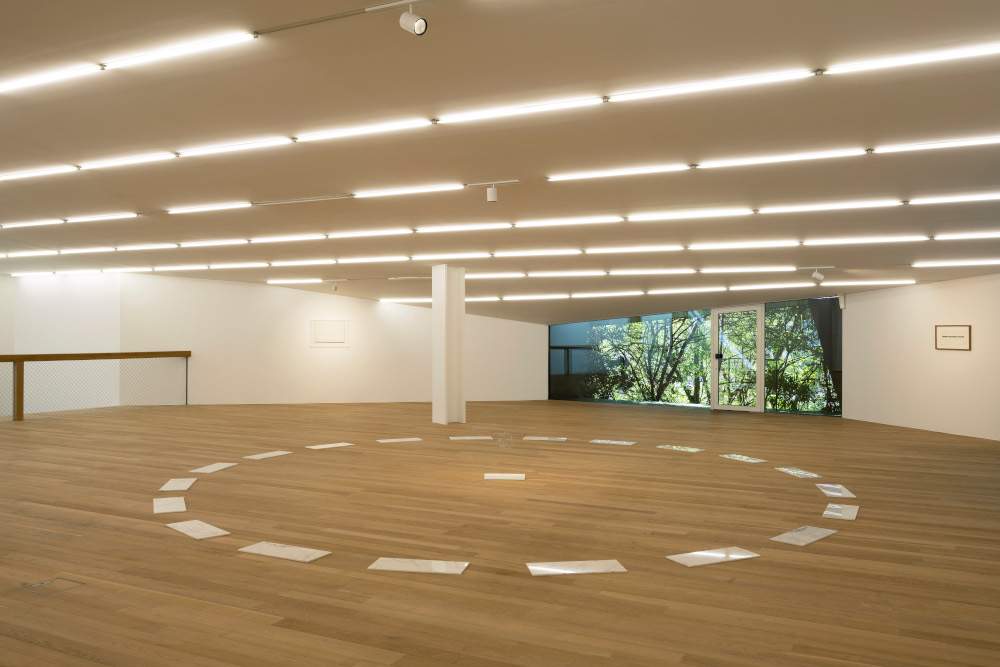From May 7, 2023 to Feb. 24, 2024, the Antonio Dalle Nogare Foundation presents I Have to Think About It, the first retrospective in an Italian institution of Argentine artist David Lamelas, the author of one of the most fascinating conceptual-based artistic investigations that emerged in the late 1960s. In the artist’s production, installation, sculpture, drawing, photography, film, video, sound, performance and textual works alternate to narrate the contexts and conditions that define our perceptions and cognitions.
Curated by Andrea Viliani and Eva Brioschi, the exhibition spans all floors of the Foundation, trespassing outside and into the rooms that house the collection to create a dialogue with some of its works. In addition to the space, the duration in time also increases: generally limited to a few weeks, the exhibition instead covers a much wider time span during which, taking different configurations, some of the artist’s most important historical works will be presented along with new productions, and an unprecedented program of live events.
Consciously self-mocking as much as self-reflexive is the title of the exhibition itself. Here Lamelas questions the very format of retrospective, to propose a personal interpretation in which the exhibition context, as well as that of the institution, represent elements of a discourse in the making, to also accommodate aspects of impermanence and the possibility of different points of view that respond to the context in which the exhibition experience is set up.
In this revision and rarefaction of the retrospective format, Lamelas predisposes the exhibition as a further exploration of the concepts of space and time, which have characterized all of his research. By working on a set-up not confined to a defined space, and by rhythmizing the exhibition’s time to the longer, moving time of perception and thought, Lamelas invites the audience to consider the dimensions of space and time as something interpretable, and therefore variable: more than concepts, in fact, for Lamelas space and time are contextual and relative happenings (and for this reason experienceable and narratable in multiple variations) in the interpretation of which the author co-participates with other subjects, starting with the audience, often formed by other artists or participants in his performative actions, invited by Lamelas to be, as in some of the films and photographic series in the exhibition, co-authors of the work at the very moment of its creation.
Trained as a sculptor, the artist frees the work from its object and material consistency by highlighting, through his installations, the architectural or urban space that these share with the artist and the viewer, or by preferring time-based practices, such as video-film and performance practices. Time itself becomes concretely representable as “situation” (a term that first appears in the title of a 1967 work) and “activity” (the Time as Activity series initiated in 1969), just as the work becomes an instrument of “signaling” or “signaling” (the first appearance of the term dates back to the title of a 1968 work) of a space and what, in that same space, the work relates to. Moreover, at a time when, between the 1960s and 1970s, artists began to question the institutional context in order to denounce the ideologies that impose and condition the public’s narrative and experience of the work of art, Lamelas identified precisely in the exhibition space and time the opportunity to not only show works but to enhance, through them, the perception and awareness of those who observe or listen to them, anticipating in this sense by decades the so-called relational aesthetics that have emerged since the 1990s.
The artist’s attitude of deconstructing customs and expectations proper to the art system is configured, as a whole, as a radical experiment, in which the distance between art and life thins out to become direct experience and historical-critical narration of the aesthetic, chronological and geographical coordinates in which the artist finds himself operating. Space and time, real and mental, figuration and abstraction, biography and history, artist and audience, art and life are no longer distinct categories, but become an experiential and narrative synthesis, constantly variable in that it can always be interpreted, in which all Lamelas’ works consist and coexist.
Image: Exhibition set-up. Photo by Hannes Ochsenreiter
 |
| David Lamelas' retrospective reflecting on space and time at Antonio Dalle Nogare Foundation |
Warning: the translation into English of the original Italian article was created using automatic tools. We undertake to review all articles, but we do not guarantee the total absence of inaccuracies in the translation due to the program. You can find the original by clicking on the ITA button. If you find any mistake,please contact us.